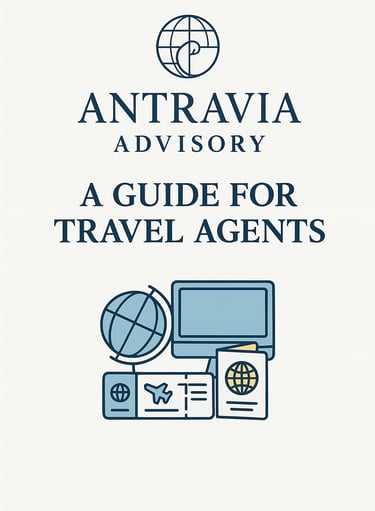
Travel Agent Finance Guide 2025: 4.3 Financing Options for Travel Agents
Part 4.3 of the Antravia Travel Agent Finance Guide explores financing options for travel agents. Understand credit lines, SBA loans, supplier terms, and investor funding, and learn how to use financing responsibly to support growth without risking liquidity.
ANTRAVIA TRAVEL AGENT GUIDE
1/15/20256 min read


Part 4: Building Financial Resilience
In the next part of our Travel Agent Finance Guide, we move beyond day-to-day accounting and look at the bigger picture: how to build a financially resilient travel business. This section will cover how to plan for growth, manage working capital, and prepare for shocks such as supplier failures or sudden drops in demand. We will also address financing options, from credit lines to investor funding, and examine how to use financial reporting to guide long-term decisions. The goal is to give travel agents a framework for sustainability, so you can not only survive but thrive in a constantly shifting industry.
4.1 Forecasting and Planning for Growth
Why forward-looking cash flow forecasts are critical
Using booking patterns, seasonality, and pipeline data to anticipate revenue
Planning for expansion into new markets or niches
Setting aside reserves during strong months to cushion weaker periods
4.2 Working Capital and Liquidity Management
Understanding the timing gap between client deposits and supplier payments
Maintaining liquidity to cover chargebacks, refunds, or delayed commissions
Best practices for separating operating capital from client money
Using short-term reserves and credit responsibly
4.3 Financing Options for Travel Agents
Credit lines and small business loans: what banks actually look for
SBA loans and financing programs in the U.S.
Investor funding: when it makes sense, when it doesn’t
Host agency advances and supplier credit terms as hidden financing sources
Surviving the first years
4.4 Preparing for Industry Shocks
Supplier insolvency: how to protect clients and your own cash flow
Sudden demand drops (pandemics, geopolitical events, recessions)
Insurance strategies: business interruption, professional liability, cyber risk
Building flexibility into your cost base so you can adapt quickly
4.5 Using Financial Reporting for Strategy
How to use profit and loss, balance sheet, and cash flow together
Identifying trends: revenue per booking, cancellation ratios, client lifetime value
Moving from reactive to proactive decision-making
Using financial data to position your agency for long-term sustainability


Part 4.3 Financing Options for Travel Agents
Financing is one of the most misunderstood areas for new and growing travel agents. Because agencies are often small and asset-light businesses, traditional lenders may struggle to understand their model. Still, several financing routes exist, each with their own requirements, risks, and timing considerations.
Credit Lines and Small Business Loans
Most banks will consider an agency for an unsecured business line of credit only once revenues are stable and recurring. In practice, this usually means at least two years of filed tax returns and consistent cash flow. A line of credit allows you to cover short-term gaps between client payments and supplier settlements. Expect to provide personal guarantees, as banks are reluctant to rely on agency assets that have little liquidation value.
Small business term loans are more rigid, but they can help fund marketing campaigns, technology investments, or hiring. The key is to borrow against growth, not against today’s operations. Lenders will want to see not just historic results but also a clear projection of how loan funds will translate into revenue.
Case Example – Credit Line Discipline
An East Coast leisure agency secured a $75,000 credit line after its third year. The owner used the line strategically during peak booking season to front supplier payments while waiting for client balances. Because she tracked cash flow weekly and repaid within 45 days, she maintained a perfect repayment record, leading her bank to extend the facility to $150,000.
What Banks actually look for
Banks do not simply review your P&L. They focus on:
Cash flow coverage: the ratio of net cash flow to expected loan payments.
Collateral or guarantees: often your personal credit score and assets.
Industry risk: travel remains volatile in the eyes of lenders. Demonstrating how your niche has resilient demand (luxury, corporate, or repeat group business) can help mitigate this.
The stronger your accounting records and the more professional your financial statements, the more likely a bank will treat you as a serious business rather than a side venture.
SBA Loans and U.S. Financing Programs
For U.S.-based agencies, the Small Business Administration (SBA) can guarantee a portion of your loan, making lenders more comfortable. Programs such as the SBA 7(a) are commonly used for working capital, while the SBA 504 is more suited to property or major equipment purchases. Approval processes are lengthy, and documentation requirements are heavy. However, the government guarantee can open doors that would otherwise be shut.
State and local economic development programs sometimes offer grants or low-interest loans for businesses that support tourism. These are less common but worth checking with your chamber of commerce.
Case Example – SBA in Action
A Midwest host agency applied for an SBA 7(a) loan of $400,000 to expand its hosted advisor platform. The agency presented detailed P&L and cash flow forecasts showing how new hires and marketing spend would translate into additional commission revenue. The loan was approved with a 10-year term, providing stability and fueling growth.
Investor Funding – When it makes sense
Equity investment is rare in traditional travel agencies, but it can make sense if you are building a scalable model, such as a host agency platform, a tech-driven service, or a group model with repeat leverage. The trade-off is ownership. Bringing in investors means giving up a share of profits and decision-making. For lifestyle agencies or smaller independents, investor capital is usually unnecessary and dilutive.
Host Agency Advances and Supplier Credit Terms
Some host agencies offer commission advances or marketing support that effectively act as financing. These should be used carefully, as advances reduce your future cash flow. Similarly, supplier credit terms, such as paying for blocks of cabins or hotel rooms after travel rather than upfront, are hidden financing sources. Both require discipline and accurate accounting to ensure future payments don’t outstrip cash inflows.
Case Example – The Cost of Overextension
A Florida cruise specialist accepted supplier credit on 100 cabins, expecting to fill them. When sales lagged, the agency faced $80,000 in payables against only $50,000 in client receipts. Without a line of credit or cash reserve, the owner resorted to high-interest credit cards (27% APR), which wiped out profit for the year. The lesson: supplier credit can be powerful but dangerous without disciplined forecasting.
Surviving the first years
The first two to three years are the hardest, when commissions are delayed, overhead is rising, and lenders remain cautious. Strategies for survival include:
Building a strong cash buffer before launch.
Keeping personal and business finances separate with proper accounting.
Using a home office or co-working space to minimize fixed costs.
Negotiating extended supplier payment terms where possible.
Avoiding high-interest credit card debt, which can sink a business quickly.
Ultimately, financing should not be treated as a lifeline but as a strategic tool for your business. Well-planned borrowing can accelerate growth, but reliance on debt to cover ongoing operations is a red flag. For travel agents, professionalism in accounting and clear cash flow projections remain the strongest financing tools of all.




References for Part 4.3 Financing Options for Travel Agents
U.S. Small Business Administration (SBA). Manage Your Cash Flow. Available at: https://www.sba.gov/business-guide/manage-your-business/manage-your-cash-flow
U.S. Small Business Administration – 7(a) Loan Program Overview
https://www.sba.gov/funding-programs/loans/7a-loansU.S. Small Business Administration – 504 Loan Program Overview
https://www.sba.gov/funding-programs/loans/504-loansFederal Reserve – Small Business Credit Survey: Report on Employer Firms (2024)
https://www.fedsmallbusiness.org/surveyU.S. Federal Reserve – Selected Interest Rates (including Prime Rate)
https://www.federalreserve.gov/releases/h15/Experian – Small Business Loan Requirements: Credit Score and Collateral
https://www.experian.com/blogs/news/2023/09/small-business-loan-requirementsU.S. Chamber of Commerce – Business Line of Credit Explained
https://www.uschamber.com/co/run/business-financing/business-line-of-creditNational Small Business Association – 2024 Small Business Access to Capital Study
https://www.nsba.biz


Acknowledgements
Antravia would like to thank our consulting clients and industry partners who generously shared their time, insights, and real-world case studies. All client examples have been anonymized and edited for clarity, but they are based on true advisory engagements and reflect real decisions, challenges, and financial outcomes from across the travel industry.
Antravia Advisory
Where Travel Meets Smart Finance
Email:
Contact us:
Antravia LLC
© 2025. All rights reserved. | Disclaimer | Privacy Policy | Terms of Use | Accessibility Statement
Antravia.com - Global site of the Antravia Group.
Antravia.com | Antravia.co.uk | Antravia.ae |
Finance.travel | Tax.travel | Consultancy.travel | Vat.travel | Vat.claims |
USSales.tax | EuroVAT.tax | UKVAT.tax |
contact@antravia.com
Antravia LLC
4539 N 22nd St., Ste. N
Phoenix
Arizona
85016
